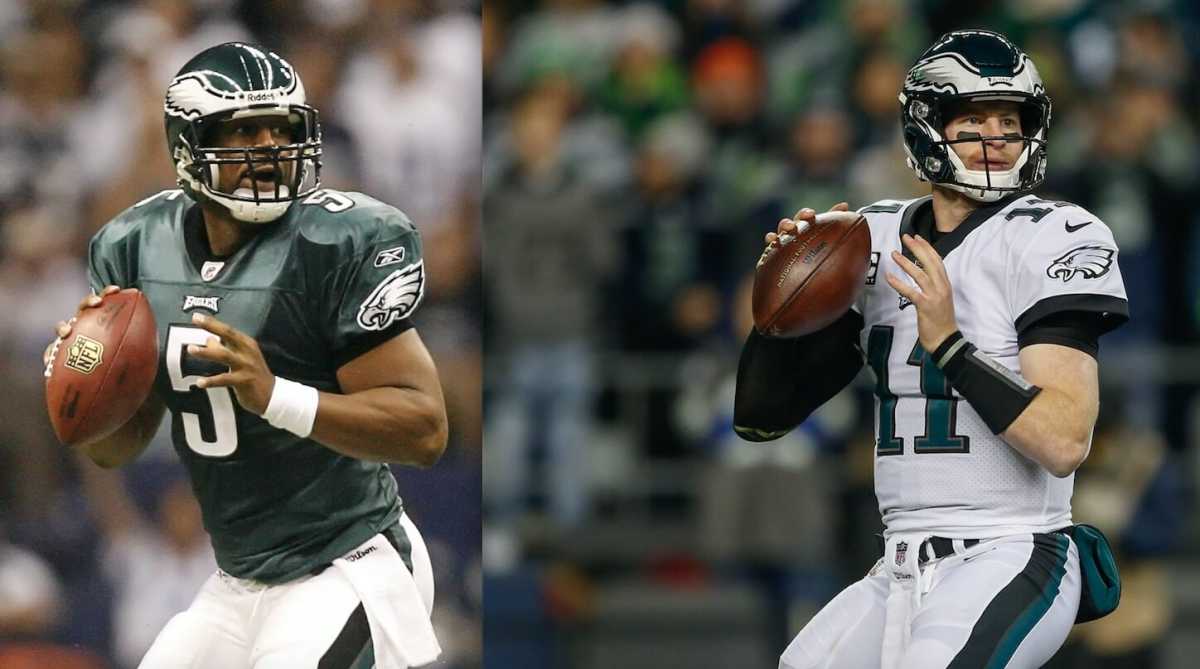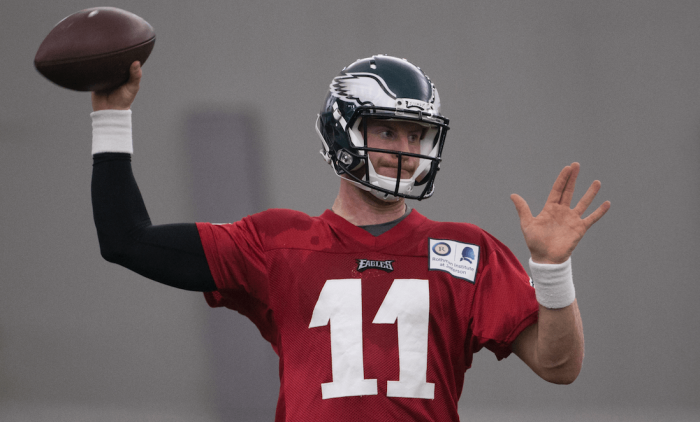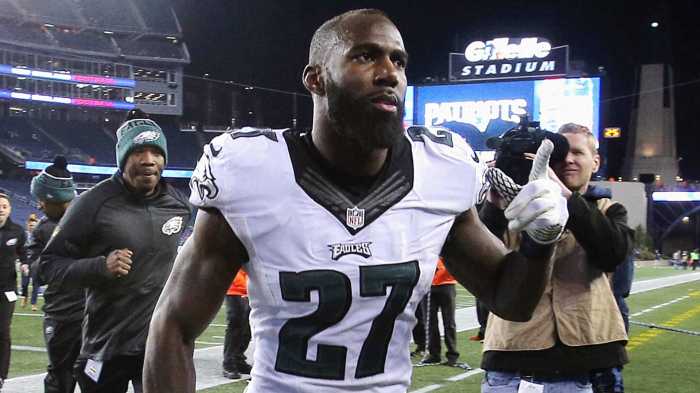The Eagles 10-1 start drew notice for all the obvious reasons. But by now you’ve probably also seen the story that every previous time the Eagles began a season this successfully, they’ve reached the NFL Championship. The quest for an elusive Super Bowl requires reaching one, so let’s see how the current Eagles season compares with the last time they reached the big game. It was (somehow) 13 years ago, and the circumstances were pretty different.
Offenses
The 2004 team managed to be a dominant offensive squad while averaging 24.1 points and 351.1 yards per game. It was a different era. Both marks had them in the top 10 in 2004 but would place them much lower in 2017. The 2017 Eagles lead the NFL with 30.1 points per game to this point, and are third with 385.1 yards. How does the 2004 team stack up to the current one’s much publicized third down success — irst in the NFL, converting 46 percent of attempts? They were middling, ranking 15th at 37 percent.
In terms of personnel, Donovan McNabb set a personal best with 31 touchdown passes, one shy of the Philadelphia franchise record. Carson Wentz is on pace to surpass that mark easily in 2017, with 29 touchdown throws through 12 games. The 2017 Eagles have relied heavily on a rotation at running back, and the 2004 Eagles were moving away from that for the first time. Correll Buckhalter and Duce Staley were gone, and Brian Westbrook was the undisputed lead back.
Finally there are obvious similarities between both the off-season acquisitions of Owens and Alshon Jeffery after years of underperforming wide receiver units, and reliance on long-established offensive lines, particularly at tackle. Tra Thomas and Jon Runyan flanked the Eagles line for a decade, and Jason Peters and Lane Johnson have become the same kind of tandem, despite their careers being unlikely to span the same timeline.
Defenses
The 2004 team finished second in the NFL, allowing 16.2 points per game and 319.7 yards per game. The 2017 Eagles are allowing 17.9 points and 293.2 yards per game. Both marks are top 6. Despite the legendary status of the Jim Johnson secondaries the current team is proving to be better ballhawks, with 16 interceptions through just 12 games. The 2004 squad finished with 17. Both teams were adamant about getting after the quarterback. In 2004 they ranked second in the NFL with 47 sacks, and in 2017 they have 33 so far, good for the top ten.
On the 2004 squad, both Jeremiah Trotter and Hugh Douglas returned after parlaying their former stardom into contracts elsewhere. Jevon Kearse was a signing that would have stolen the headlines in any other off-season. It wasn’t quite the overkill the Eagles exhibited building their defensive front this off-season, but it was up there.
The biggest difference in the makeup of the teams has to be the expectations when the seasons began for the two secondaries. The old squad had already transitioned flawlessly from one set of Pro Bowl cornerbacks, Troy Vincent and Bobby Taylor, to another: Lito Sheppard and Sheldon Brown. This year, the Eagles were still shopping for cornerbacks the week before the season began. Both defenses had leadership and versatile stardom coming from the safety position, though Malcolm Jenkins will never be able to eclipse Brian Dawkins legacy in Philadelphia, through no fault of his own.
Losses
Since it’s the first thing on everyone’s mind this week, let’s take a look at the Eagles’ two losses. The 2017 Eagles have lost to the Chiefs, a mind boggling unit that began the season 5-0 and is now 6-6, and the 8-4 Seahawks. The 2004 Birds suffered their first loss against a Steelers team that would finish 15-1 with a rookie Ben Roethlisberger at the helm, and their final two games against .500 Rams and Bengals squads. For those two games, the Eagles starters were rested.
But how did the teams lose? This year with both the Eagles and Steelers playing well, there’s been significant talk of a Pennsylvania Super Bowl, and when the 7-0 Eagles faced the 6-1 Steelers in 2004 the same talk existed. This game put a pin in that for awhile. The Steelers outgained the Eagles 420-113, jumped to an early lead that made the worst in Andy Reid’s play calling come out — the Eagles ran the ball nine times and zeroed in on Terrell Owens (he had seven of the eight receptions by a wide receiver.) They left Pittsburgh 27-3 losers.
In the current squad’s two losses, they have outgained the other team both times (406-344 vs. Chiefs and 425-310 Sunday night) but lost the turnover battle two-nil each time. Against the Chiefs they abandoned the run somewhat (17 for 107) but against Seattle they stuck with it (26 for 98) despite having less success and being in a hole earlier. After they suffered their first loss in 2004, their next four games featured an average margin of victory of 25 points. This team responded to their first loss with nine straight victories. How they respond to their second will matter as much.
History
One of the biggest differences between the two teams is the preceding seasons. The 2004 team felt in every way a culmination of years of groundwork and planning. The Eagles had made the playoffs the four seasons prior, and won the division and lost in the NFC Championship game the previous three. After years of pining for wide receiver help, Owens signing had fulfilled that wish and then some. The 2004 team was supposed to do exactly what it was doing and anything less would have been a regression and disappointment.
This year’s team, for anyone following, is obviously in quite a different situation. They’re in only their second season with Doug Pederson, barely removed from a tumultuous three year relationship with Chip Kelly and only five years removed from the final collapse of the Reid era in 2012. The roster has seen significant upheaval for three straight off-seasons. The team had not made the playoffs since 2013, and few players were here then.
Both teams entered the season believing in franchise quarterbacks they held, but in 2004 McNabb had made the previous four Pro Bowls, once finished second in MVP voting, and won four playoff games. Carson Wentz was entering his second season without a Pro Bowl appearance or playoff appearance to his name. A similar comparison exists between Reid and Pederson. Reid had won a Super Bowl with the Packers, and already been named Coach of the Year for his work in Philadelphia twice by 2002. Pederson was forced to suffer the slings and arrows of outrageous commentary as recently as this offseason.




























